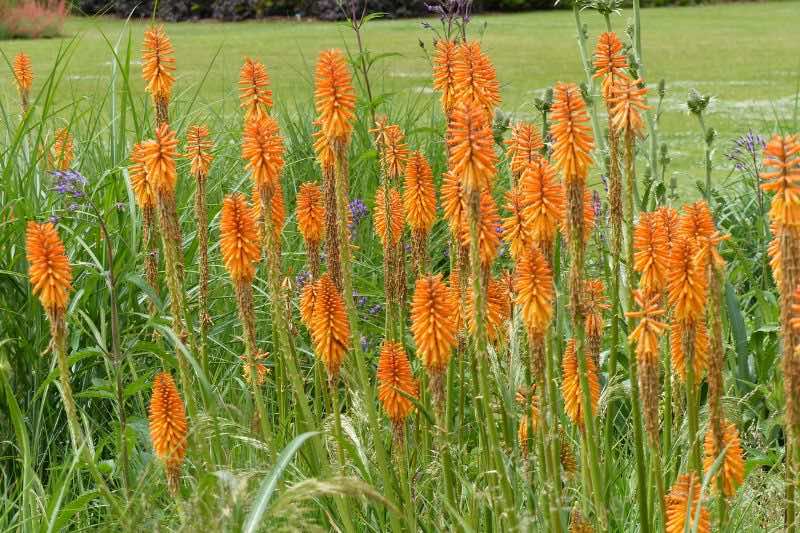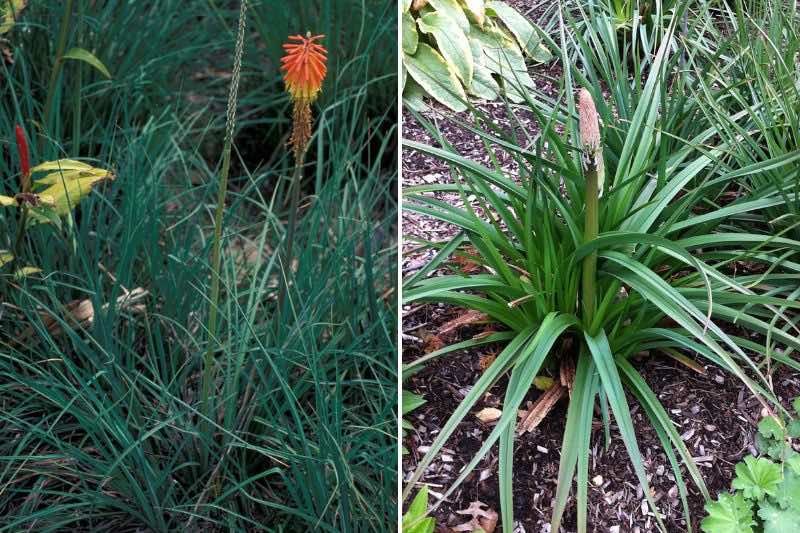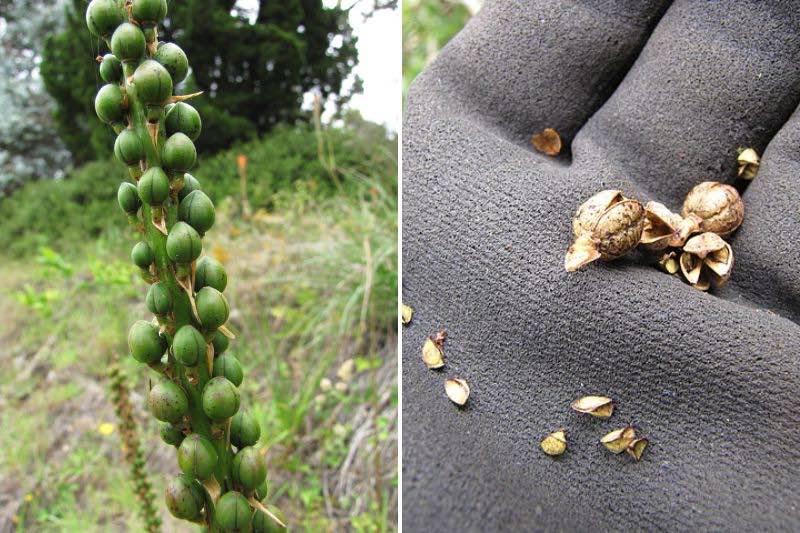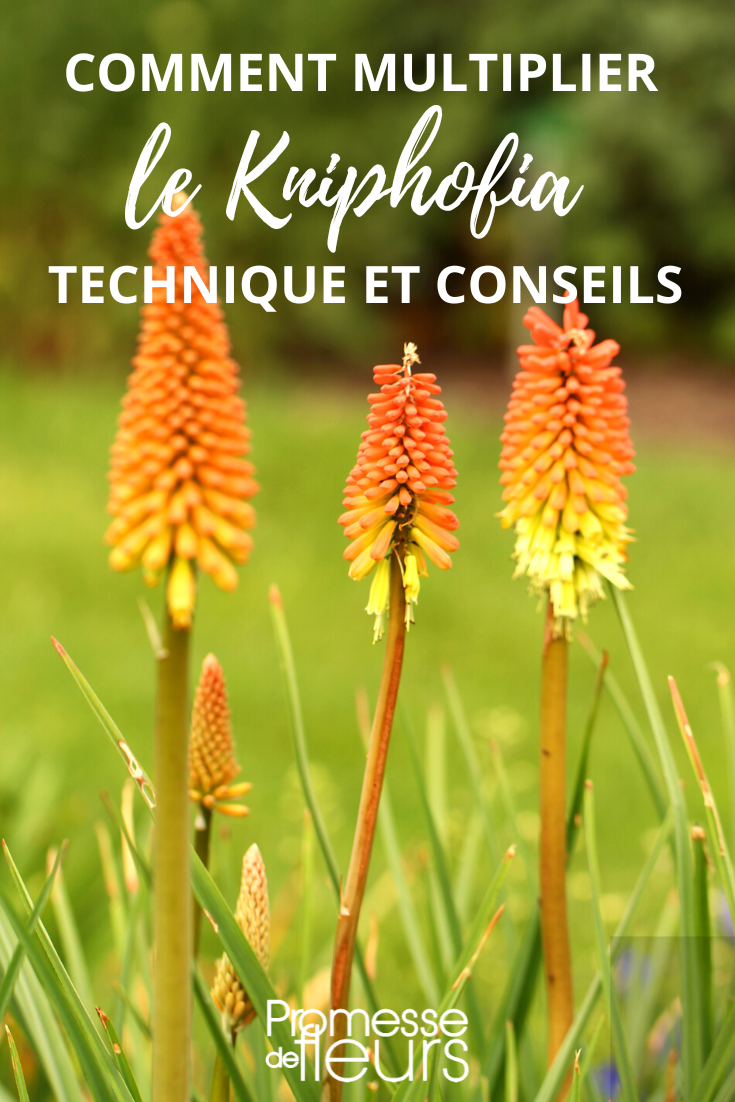Kniphofia is a rhizomatous perennial native to South or East Africa, prized for its flamboyant flower spikes in vivid colours, which persist through summer. Standing 50 cm to 1.20 m tall depending on variety, Kniphofia forms a generous clump with an upright, fan-shaped habit, slightly trailing, of glossy, narrow leaves, evergreen or deciduous depending on hybrids and species. From this clump emerges, from June until October, an especially exotic display of vertical spikes held well above foliage, in single or bicoloured tones. Kniphofia, also called Tritoma or "Devil's poker" in reference to its canary-yellow, coral-orange or intense-red spikes, grows in sun in well-drained soil. Under these conditions, it is hardy down to -12 to -15°C provided the stump is protected with a thick mulch. Notable exception is botanical species Kniphofia uvaria, perfectly hardy to -30°C! If well-drained soil is rich and remains cool in summer, Kniphofias develop their clump fairly quickly and can even become invasive. In that case, we recommend dividing them after 3 or 4 years. Kniphofias can also be propagated by sowing. Here is how to carry out both methods.

Dividing Kniphofia
This is the simplest and most suitable method to multiply your plant. Quick and economical, it provides new plants to enlarge borders, give to a neighbour or friend, or to fill pots. This technique also renews a plant exhausted after several years of cultivation or too cramped in its position. New plants obtained are identical to mother plant. However, vigorous, the Kniphofia stump can prove fairly difficult to divide, tough under the spade. It is preferable not to wait until plant is too large before carrying out this method.

When and how to divide kniphofia?
Quite quickly, after third or fourth year of cultivation, kniphofia can form an imposing clump. It is then useful to divide its stump to rejuvenate it. If growth is less vigorous, wait until stump is well established and sufficiently substantial to withstand a division. Work takes place in early spring, before vegetative growth resumes.
- Work with sharp, disinfected tools.
- Choose future planting place(s) for offsets, prepare planting holes.
- Mark a perimeter around mother stump with a spade, working carefully, not too close to avoid damaging roots and stump.
- Expose stump and place it nearby.
- Separate clump by cutting into two or more pieces using spade.
- You can also use a knife if clump is not too large or at its periphery.
- Cut damaged roots and, if necessary, unsightly stems with pruning shears.
- Add amendments to planting hole of mother plant before replacing it and do same in holes for offsets. Well-rotted compost, manure or potting compost will enrich soil.
- Place mother plant and offsets in their respective planting holes.
- Water thoroughly.
- Protect plants with an organic mulch a few centimetres thick.
- Monitor watering during first weeks to encourage establishment. Keep soil moist or cool.
Sowing kniphofia seeds
Seed harvest takes place at ripeness, in autumn, on flower stems left uncut. Some recent varieties are early and perpetual; they begin flowering in May for about two months and rebloom at end of summer. It is therefore after this second flowering that seeds form. Sowing requires some patience and needs a heated, bright space and careful monitoring until planting out. If you want to try original sowing, you can buy kniphofia seeds and even Kniphofia uvaria, botanical species very hardy.

When and how to sow kniphofia seeds?
Sowing of seeds is done in March or in September–October. You should previously have stratified seeds for 6 weeks. This technical term means you placed them in fridge in vegetable drawer.
- Fill buckets with seed compost or a fine-structured potting compost to which you can add some sand.
- Firm down lightly to obtain a level surface.
- Sow a few seeds.
- Cover with a thin layer of compost.
- Water gently with a fine spray, ideally using a mister.
- Keep under cover at 15–20°C, in a bright place without direct sun, ensuring compost remains slightly moist.
- You can place a small transparent cover (glass or plastic) over the pot to retain moisture in the compost.
- Label your sowings: plant, variety, date of sowing.
- Seedlings emerge in 14 to 30 days.
- When seedlings reach 5 cm, transplant into individual pots 7 cm in diameter. Keep most vigorous specimens.
- Move them outdoors once risk of frost has passed.
- Plant now vigorous Tritoma plants in garden or in pots — that is, the following year if sowing was done in autumn.
- Prepare soil or substrate by enriching with amendments such as compost, manure or potting compost.
































Comments